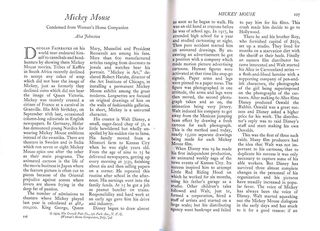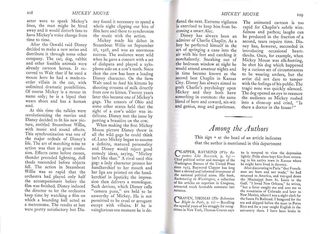In this Readers Digest (August 1934) version of an article from the July 1934 Woman's Home Companion, we find on page 108 a simple description of the bouncing ball system to record Steamboat Willie...
Douglas Fairbanks on his world tour endeared himself to cannibals and headhunters by showing them Mickey Mouse movies. Tribes of Kaffirs in South Africa recently declined to accept any cakes of soap which did not bear the image of Mickey, just as formerly they declined coins which did net bear the image of Queen Victoria. Mickey was recently created a citizen of France at a carnival in Granville. His fifth birthday, on September 28th last, occasioned column-long editorials in English newspapers. In Germany, Hitler has denounced young Nordics for wearing Mickey Mouse emblems inStead of the swastika. There are theaters in Sweden and in India which run seven or eight Mickey Mouse epics one after the other as their main programs. The animated Cartoon is the life of the movie business in Japan where the feature picture is often cut to pieces because of the Oriental prejudice against scenes where lovers are shown frying in the deep fat of passion.
The number of admissions to theaters where Mickey played last year is calculated at 468,000,000. King George, Queen Mary, Mussolini and President Roosevelt are among his fans. More than 600 manufactured articles ranging from doormats to jewels and watches hear his portrait. "Mickey is Art,” declared Robert Harshe, director of the Art Institute of Chicago, in installing a permanent Mickey Mouse exhibit among the great modems. Lorgnettes are focused on original drawings of him on the walls of fashionable galleries. In short, Mickey is a universal character.
His creator is Walt Disney, a small, eager-faced chap of 32, a little bewildered but wholly unspoiled by his sudden rise to fame. His family moved from a Missouri farm to Kansas City when he was eight years old. From the age of nine to 15 he delivered newspapers, getting up every morning at 3:30, finishing about six and then selling papers on a corner. He repeated this routine after school in the afternoon. His earnings went into the family funds. At 15 he got a job as peanut butcher on trains. Responsibility and hard work at an early age gave him his drive and industry.
[…]
DIX note
The original article from the July 1934 Woman's Home Companion mentioned by Hans Perk may be found in Garry Apgar's book "
A Mickey Mouse Reader" (pp. 105-115)
Check
this ebay auction for an image of the first double page.

